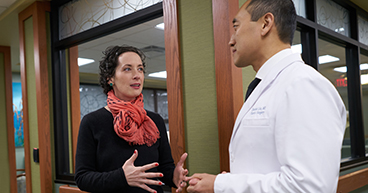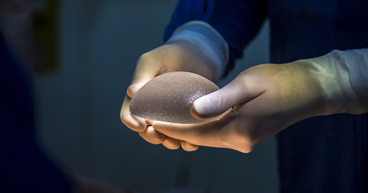
Undergoing a mastectomy can prove instrumental in a breast cancer patient’s treatment plan. But the procedure often comes with its own challenges, especially for women struggling with body image after surgery. To help these patients recover a sense of normalcy, some reconstructive surgeons are turning to an age-old tool—the tattoo gun. The 3D nipple tattoo, or “nat” as it’s called in the trade, uses shadows and highlights to restore a sense of depth and detail to the reconstructed breast.
Dr. Rola Eid, Medical Director of Plastic and Reconstructive Surgery at our hospital in Tulsa, says the technique can go a long way in helping patients feel whole again. “Artistry and plastic surgery go hand in hand,” says Dr. Eid. “The nipple/areola is a defining characteristic of the breast and a natural focal point for the eye, so to be without this feature strays away from what appears natural.” Self-image is critical to patients’ sense of well-being. Those who want a more natural appearance after breast reconstructive surgery may opt for a 3D nipple tattoo, which uses a tattoo gun to ink a high-resolution image of a nipple and areola onto the breast. Other patients may choose to have a nipple reconstructed during surgery. “Either choice is patient-specific,” adds Dr. Eid.
Earlier versions of the nipple tattoo were typically one-dimensional, using a single color—peach, salmon or eggplant—to paint one or two concentric circles onto the breast. More recent 3D techniques offer a more realistic appearance by drawing from multiple shades and shadows. Today’s expanded color palette uses 15-20 hues of organic, non-toxic pigments. “Compared to existing alternatives, 3D tattooing creates a more natural-looking breast,” says Dr. Eid. The tattooing procedure takes about 90 minutes to two hours, typically over one visit, though some women opt for a second follow-up visit for refinements. Dr. Eid says she advises patients to allow their body to heal for five to six months after breast reconstruction surgery before receiving a nipple tattoo “to ensure optimal color pigment retention.”
An expert in a broad range of breast, facial and cosmetic reconstructive surgery techniques, Dr. Eid was inspired to learn more about 3D nipple tattooing when she spotted “an incredibly realistic-looking eye tattoo on a friend’s arm.” She asked her friend who did the work, and met Bruce Joy, an award-winning tattoo artist from the Tulsa area who agreed to train her in painting intricate images with a tattoo gun. The lessons began earlier this year, when Joy guided Dr. Eid through the use of professional-grade tattoo equipment, color theory and custom color-mixing, as well as shadowing, highlighting and color transitions. By customizing colors to match various skin tones, Dr. Eid says she strives for a realistic result for each patient, even drawing hints of the sebaceous Montgomery glands often seen around the areola.
“You become aesthetically focused when performing cosmetic techniques for patients with exacting expectations. Even the smallest of details are important,” says Dr. Eid. “I believe breast cancer patients deserve the same aesthetic focus as elective cosmetic patients.” She knows this on a personal level, inspired after watching her mother battle breast cancer, and witnessing the effect breast reconstruction had on her. “I saw firsthand the transformative and restorative power of plastic surgery,” Dr. Eid says. “My mother was back to being the social butterfly she used to be.”
Learn more about side effects that come with breast cancer surgery.


